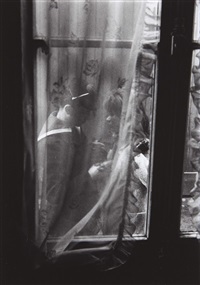

Soirée at the Home of Princess Chavchavadze, 1947 (courtesy Betty He) In a way, he is also turning his head, only pointing his camera to depict varying relationships in the city without commentary. Their hidden faces leave the picture emotionally neutral, so that Brassaï does not judge either of them. Although the man has his back to the naked prostitute, his sight aligns with her image in the mirror.

That intimacy is lost in “Chez Suzy” as the mirror reflects not a loving look but a voyeuristic gaze. Chez Suzy, 1931-1932 (courtesy Betty He).Couple in a Café Near the Place D’Italie, 1932 (courtesy Betty He).Their brief interaction lives on in an infinite reflection between the mirrors, which is Brassaï’s effective way to let their intimacy resonate with viewers through time. As the woman leans back with a playful smile, her flamboyance is balanced by her partner’s intent gaze captured in the mirror behind her. This venture into spatial depth is replaced by an exploration of emotional depth in “Couple in a Café.” A mirror animates the couple’s relationship with new life. Boundaries between the real and imaginary are blurred in “Gala Soirée at Maxim’s,” where the mirror reaches deeper into the restaurant as a continuation of what could not fit within the camera frame. In Brassaï’s photographs, mirrors happen upon the perfect place at a perfect angle to expose a side of Parisians hidden from the camera.

Under his lens, the honest Paris unfolds - dirty, forlorn, hysterical, delusional - each character a work of art. His famous photography collection, “Paris de Nuit,” wanders through the streets of Paris at night, illuminated by foggy lamplight. Born in 1899, Gyula Halasz adopted the pseudonym Brassaï in honor of his hometown of Brasso, Transylvania. His photography is, in itself, a mirror of society, capturing its most promiscuous aspects within the photos, mirrors are used to reveal people’s best kept secrets - our emotions. In the strictly realistic realm of photography, Brassaï expands into the magical space of mirrors. Under Brassaï’s lens, Paris is shrouded with mystery, yet in the darkness of shadows, truths creep out.


 0 kommentar(er)
0 kommentar(er)
